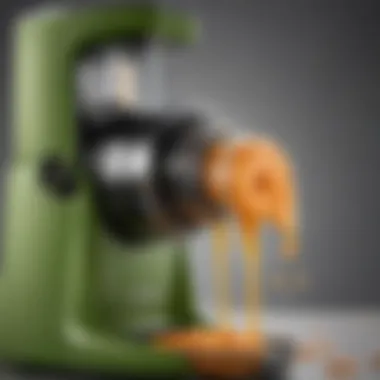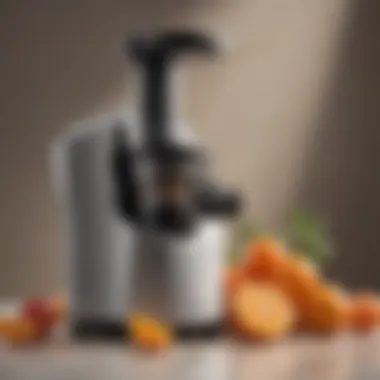Understanding Juicer Costs: An In-Depth Analysis


Intro
In recent years, the trend for healthier lifestyles has gained significant momentum. Many individuals and families are looking for ways to incorporate fresh produce into their daily diets. One way to achieve this is by investing in a juicer. However, the decision to purchase a juicer involves understanding its costs, features, and long-term benefits.
This analysis delves deep into the factors that affect juicer pricing, including the type of juicer, brand reputation, and available features. It also weighs the advantages of owning a juicer, particularly focusing on health benefits and potential savings over time. With various models on the market, potential buyers can easily become overwhelmed with options. Thus, this article aims to streamline your decision-making process, providing clarity in the often confusing world of juicer costs.
Types of Juicers and their Cost Implications
Juicers primarily come in three types: centrifugal, masticating, and twin gear juicers. Each type has unique characteristics and implications on pricing.
- Centrifugal Juicers: These are typically the least expensive option. They operate by quickly spinning the produce to separate juice from pulp. Common brands include Breville and Hamilton Beach, with price ranges from $50 to $200. They are often favored for their speed and ease of cleaning.
- Masticating Juicers:
Also known as cold press juicers, these devices extract juice at a slower speed. This method helps retain more nutrients and flavor. Brands like Omega and Kuvings dominate this space. Masticating juicers usually range from $200 to $500, making them a pricier choice but worth considering for those seeking quality juice. - Twin Gear Juicers: These are the most expensive and complex juicers available. They employ two rotating gears to process fruits and vegetables, maximizing juice yield. Champion and Green Star are notable names, with prices typically exceeding $500. This type is best for serious juicers who want maximum efficiency.
"Choosing the right juicer depends on both personal preferences and budget constraints. Prioritizing your health goals will guide you to the ideal product."
Evaluating Juicer Features
The cost of juicers fluctuates according to their features. Essential features to consider include:
- Juice Yield: Higher-end models generally offer better juice extraction.
- Cleaning Ease: Some juicers have complicated parts that can be challenging to clean.
- Durability: Investing in a sturdy model can save money in the long run, as it will require less frequent replacement.
- Versatility: Some juicers can handle a variety of tasks, such as making nut butters or frozen desserts.
Long-Term Cost Benefits
Although the initial expense of a juicer can be substantial, the long-term benefits are worth considering. Fresh juice can lead to increased health, potentially reducing future medical costs.
- Grocery Savings: By making juice at home, consumers can save on purchased juices, which often come with high markups.
- Health Investments: Regular consumption of fresh juice may lead to better health and hence lower healthcare expenses.
In summary, understanding juicer costs involves more than mere dollars and cents. It requires knowledge of the product's type, features, and potential benefits. This guide provides a structured approach for potential buyers to navigate their options effectively.
Preamble to Juicer Costs
In the current era, where health consciousness is a pivotal concern for many, the relevance of juicers cannot be overstated. A juicer not only facilitates the preparation of nutritious beverages but also encourages healthier dietary choices. Understanding the costs associated with these appliances is vital for consumers. It empowers potential buyers to make informed decisions catering to both their health goals and budgetary constraints.
Defining a Juicer
A juicer is a kitchen appliance designed to extract juice from fruits, vegetables, and other food items. The primary function of a juicer is to separate liquid juice from the fibrous pulp of these ingredients, allowing users to enjoy the nutritional benefits in a convenient form. Different types of juicers, including centrifugal, masticating, triturating, and manual devices, vary in their operation, efficiency, and output.
Centrifugal juicers function quickly, using high-speed blades to create juice within moments. Masticating juicers, however, work at a slower pace, utilizing a single auger to squeeze juice out of produce, which generally leads to higher juice yields and better nutrient retention over time. Understanding these basic distinctions helps one evaluate the suitability of different juicer types based on individual needs.
The Importance of Understanding Costs
Grasping how much various juicers cost is essential for several reasons. Firstly, it sets realistic expectations for consumers considering an investment in these appliances. Costs can range from affordable manual juicers to high-end models that require a larger financial commitment. Understanding this landscape will guide consumers in selecting a model that offers functionality without overshooting their budget.
Moreover, considering costs is not only about the initial purchase price. Long-term operational costs, such as electricity consumption and the price of ingredients, contribute significantly to the total expense of owning a juicer. Through a comprehensive analysis of all these factors, consumers can anticipate and minimize future expenditures effectively.
"Understanding the costs associated with juicers is essential for making informed choices that align health with budget."
Furthermore, taking into account features and brand reputations also plays a crucial role in juicer selection. As such, analyzing costs is pivotal not just for containment within financial limits but also for maximizing the overall value derived from the purchase.
Types of Juicers and Their Pricing
Understanding the different types of juicers along with their pricing is essential for anyone considering purchasing one. Each type has its own unique features and price ranges that suit various juicing needs. This article will provide detailed insight into centrifugal, masticating, triturating, and manual juicers. Each of these categories has distinct attributes that influence their performance, ease of use, and cost. By knowing this information, potential buyers can select a juicer that aligns with their juicing habits and budget.
Centrifugal Juicers
Overview and Cost Range
Centrifugal juicers are among the most commonly used types due to their speed and efficiency. They function by using a rapidly spinning blade that grates the fruit or vegetable, extracting juice through centrifugal force. The price for these juicers can range from about $30 to over $300. Factors affecting the price include the brand, construction materials, and overall build quality. Their popularity largely stems from their ease of use and quick juicing process, making them a practical choice for those who desire convenience.
Advantages and Disadvantages


One key advantage of centrifugal juicers is their speed. They can produce juice in a matter of seconds, appealing to those with a busy lifestyle. However, they do have some disadvantages. The juicing process can generate heat, which may diminish the nutritional quality of the juice. Additionally, they are generally less effective at extracting juice from leafy greens and soft fruits compared to masticating models. This section emphasizes weighing faster juicing against potential nutrient loss.
Masticating Juicers
Overview and Cost Range
Masticating juicers, also known as slow juicers, operate at lower speeds and use a single auger to crush and squeeze the produce. The cost range usually lies between $100 and $500, depending on brand and added features. While they may take a bit longer to extract juice compared to centrifugal models, they tend to yield higher-quality juice that retains more nutrients and enzymes.
Advantages and Disadvantages
The main advantage of masticating juicers is their ability to extract juice from a wider range of produce including leafy greens, nuts, and hard vegetables. They produce juice with a longer shelf life due to the reduced oxidation. On the downside, they can be more expensive and may take longer to clean due to multiple parts involved. This section will underscore the potential for nutrient-rich juice, which is a crucial factor for health-conscious consumers.
Triturating Juicers
Overview and Cost Range
Triturating juicers, commonly referred to as twin gear juicers, use two gears to grind and juice the produce. The investment for these juicers typically starts at around $300 and can exceed $1,200. Their advanced design allows for an exceptional yield and maximum nutrient retention, making them a premium choice for dedicated juicers.
Advantages and Disadvantages
A key feature of triturating juicers is their efficiency in extracting juice. They efficiently handle a wide variety of produce, including hard fruits and vegetables, nuts, and leafy greens. The downside is the price and the fact that they can be more complex to operate. Moreover, cleaning these juicers can be more cumbersome. This section will detail how these benefits cater to a niche market of juice enthusiasts.
Manual Juicers
Overview and Cost Range
Manual juicers make fresh juice through hand-cranked methods or simple levers. The cost of these juicers is usually between $20 and $150, making them an affordable option for users who prioritize simplicity. They require no electricity and are often compact, which can be advantageous for small kitchens or travel.
Advantages and Disadvantages
The primary advantage of manual juicers is their affordability and portability. They are straightforward to operate and require minimal cleaning. However, the disadvantage lies in the effort needed to extract juice. The efficiency is lower, especially when juicing larger quantities. This section highlights the suitability of manual juicers for occasional users or those who favor a more hands-on juicing experience.
Factors Influencing Juicer Prices
Understanding the factors that influence juicer prices is essential for potential buyers. The cost of a juicer does not solely depend on its type but is affected by a multitude of elements. Analyzing these factors helps consumers make informed decisions based on their needs and budget.
Brand Reputation
The reputation of a brand plays a significant role in determining the price of juicers. Brands that have established themselves over time tend to charge more for their products. Known brands like Breville and Omega often incorporate advanced technologies that enhance the juicing process. Consumers perceive these brands as more reliable, resulting in higher demand. This increased demand justifies the elevated price point. Additionally, established brands often provide better customer support, which adds value to their products. The trust built over time also contributes to their costs.
Build Quality and Materials
Build quality and materials used can greatly influence the pricing of juicers. High-quality materials like stainless steel or BPA-free plastics are typical in more expensive models. These materials ensure longevity and a more efficient juicing process. Cheaper juicers often use inferior materials, which may result in a shorter lifespan and a subpar performance. Additionally, models made from durable components may offer more stability and less noise during usage. Thus, investing in a sturdily built juicer is often more beneficial in the long run.
Juicer Features
Features are among the most critical factors that affect juicer pricing. Different features can significantly enhance the juicing experience, but they also come at a cost.
Speed and Efficiency
Speed and efficiency are crucial aspects that appeal to consumers. Fast juicers reduce the time required for preparation, which is advantageous for those with a busy lifestyle. Effective extraction methods also mean more juice is obtained from ingredients, maximizing the product's value. Juicers that are efficient may come with increased price tags, reflecting the technology and engineering involved in their design. Therefore, consumers often find that prioritizing speed and efficiency can lead to better overall satisfaction.
Ease of Cleaning
Ease of cleaning is another important feature to consider. Juicers that are easier to clean require less time and effort, making them ideal for regular users. Some advanced models come with self-cleaning features or dishwasher-safe components. These convenience factors can justify higher prices as they save time, allowing users to enjoy their juice without the hassle of extensive cleanup. In contrast, models that lack these features may cost less but can become burdensome over time.
Additional Accessories
Additional accessories can also influence juicer prices. Some juicers come with multiple attachments or specialized tools, increasing their value. Accessories can include items like strainers or different juicing cones. These add-ons enhance versatility, allowing users to experiment with various recipes. While a base juicer might be affordable, the inclusion of useful accessories can raise the overall price, reflecting the broader functionality and convenience they offer.


Warranty and Customer Support
A robust warranty and reliable customer support often correlate with a higher price point. Established brands tend to offer longer warranties, which reflect their confidence in the product quality. In addition, responsive customer service enhances the user experience. Buyers are likely willing to pay more for a juicer that comes with solid support options. This investment ensures they can seek help if issues arise, making the purchase feel more secure.
Overall, consumers must evaluate all these factors when considering juicer prices. Each element contributes to the final price, underscoring the importance of selecting a juicer that meets both needs and budget.
Long-Term Cost Considerations
When considering the purchase of a juicer, long-term cost considerations play a significant role. It is not just the upfront price that one should evaluate but also what the juicer will cost over time in terms of electricity, ingredients, and health benefits. Understanding these elements can help consumers make informed choices that align with their financial and health goals.
Operational Costs
Electricity Consumption
Electricity consumption is an important factor when thinking about the overall cost of using a juicer. Different types of juicers vary in terms of how much electricity they use. For instance, centrifugal juicers may consume more power, while masticating juicers tend to be more energy-efficient.
A juicer that uses less electricity may seem like a popular choice because it can lower monthly bills. The unique feature of energy-efficient juicers is their ability to extract juice while consuming less power. This not only benefits the environment but also offers savings in the long run.
Ingredient Costs
Ingredient costs are another element that significantly impacts the long-term investment in a juicer. The type of ingredients used can vary widely, affecting the overall expenses. For example, organic produce can be more costly, yet it can provide better health benefits. Conversely, buying cheaper produce may result in savings but could compromise nutritional value.
One of the main characteristics of ingredient costs is that they are recurring. Therefore, it is essential to consider which ingredients will be utilized regularly. This consideration affects budgeting and can lead to substantial savings or expenditures depending on the choices made.
Health Benefits and Savings
Investing in a juicer may lead to significant health benefits. These benefits can be viewed as long-term savings since healthier eating habits can reduce medical costs over time. For example, juices made from fresh fruits and vegetables can enhance immunity and contribute to general well-being.
Moreover, juicing at home can be more economical than purchasing pre-made juices from stores. This not only ensures freshness but also allows for better control over the ingredients used, potentially leading to a healthier lifestyle.
"An investment in a good juicer is also an investment in your health."
In sum, long-term cost considerations extend beyond the initial purchase of a juicer. Paying close attention to operational costs, ingredient costs, and the potential health benefits can lead to wise financial and health-related decisions.
Comparative Analysis of Popular Juicer Brands
The importance of analyzing popular juicer brands lies in simplifying the decision-making process for potential buyers. With a variety of options available, it can be overwhelming to choose the right juicer. This comparative analysis focuses on notable brands, highlighting their unique attributes, strengths, and weaknesses. This allows consumers to see how different models stack up against each other in terms of cost, performance, and user satisfaction.
Brand A
Price Range
Brand A's price range varies significantly, typically falling between $100 and $300. This range provides flexibility, catering to both budget-conscious users and those willing to spend more for advanced features. The mid-range pricing is appealing because it often indicates a balance between quality and affordability, making it a popular choice. Users appreciate that they can find a model that meets their requirements without excessive spending.
One notable feature of Brand A is its reliability and durability, which can justify a higher initial investment. However, potential buyers should consider that lower-priced options may not offer the same long-term value. It's essential for consumers to evaluate what they need in a juicer and whether Brand A's costs align with those requirements.
User Reviews
User reviews for Brand A reveal insights about satisfaction and functionality. Many reviews highlight the ease of use and straightforward operation of the juicer. People favor this brand due to its consistent performance, which contributes to its positive reception.
Additionally, a unique aspect of the user feedback is the brand's customer service. Many users report helpful experiences when contacting support. However, some reviews indicate occasional issues with particular models, such as jamming. While these concerns exist, overall, the brand maintains a solid reputation based on user experiences.
Brand B
Price Range
Brand B positions itself within a price bracket starting at $150 and extending to $400. This higher price point is often associated with advanced technology and higher-quality materials. Consumers interested in purchasing Brand B may find the premium cost justified by unique features, such as enhanced augers for better juice extraction.
What distinguishes Brand B in its price range is its focus on delivering superior performance, often resulting in greater juice yield and better nutrient retention. However, buyers must weigh whether the additional features and benefits align with their personal juicing habits and budget constraints.


User Reviews
Examining user reviews for Brand B highlights varying opinions. On one hand, many users praise its capability to produce high-quality juice with minimal effort. Users often mention the efficient cleaning process, which is a crucial consideration for many buyers.
On the other hand, some reviews express concerns about the weight and bulkiness of certain models. This feedback suggests that while the juicer performs excellently, its size might not be suitable for everyone, particularly those with limited kitchen space. Overall, the consensus is positive, with many recommending Brand B for serious juicing enthusiasts.
Brand
Price Range
Brand C is a more affordable option, with prices ranging from $80 to $150. This accessibility makes it a viable choice for beginners and casual juicing enthusiasts. The entry-level pricing often attracts those who are just starting their juicing journey and do not want to invest heavily at first.
Despite its lower cost, Brand C offers some unique features, such as compact designs and ease of storage. However, potential buyers should be cautious as lower prices can sometimes correlate with lower durability and possibly reduced performance over time.
User Reviews
User reviews for Brand C often emphasize its suitability for novice users. Many appreciate the straightforward functionality and compact size of the juicers. This brand's models are frequently described as user-friendly, making them an excellent choice for those looking to explore juicing without a steep learning curve.
However, there is feedback pointing to less durable materials compared to higher-priced brands. Some users report issues with performance when processing harder produce. Thus, while Brand C may serve beginners well, those who enjoy juicing regularly might want to consider investing in a more robust model for better results.
Understanding the strengths and weaknesses of each brand empowers consumers to make informed choices that suit their juicing needs.
Consumer Tips for Purchasing a Juicer
When considering the purchase of a juicer, understanding the various aspects can help consumers make informed choices. Juicers come in different types, styles, and price ranges. This diversity can lead to confusion among potential buyers. That is why knowing what to look for is essential. A well-informed purchase ensures optimal satisfaction, both in functionality and budget management.
Identify Your Juicing Needs
The first step in choosing a juicer is identifying your personal juicing needs. How often do you plan to use it? Are you focusing on specific fruits and vegetables? Different juicers serve various purposes. For instance, if you mainly want to juice leafy greens, a masticating juicer might be preferable. On the other hand, for quickly juicing harder fruits, a centrifugal juicer may suffice.
Furthermore, think about the volume of juice you want to produce at a time. If you're prepping juices for more than one person, consider larger juicer models or those with higher efficiency. Evaluate your overall lifestyle too; if you travel frequently, a compact, easy-to-clean manual juicer could be a good fit.
Budgeting for a Juicer
Budgeting is critical when it comes to purchasing a juicer. The prices vary widely, ranging from affordable to high-end models. Low-cost options may compromise on durability and efficiency. In contrast, expensive models can offer superior quality, advanced features, and longer lifespans.
It's also important to not only focus on the initial purchase price but also on the long-term costs associated with ownership. Consider the durability of the product. Machines prone to frequent repairs might become more expensive over time. Additionally, investigate the cost of parts and accessories, like replacement filters.
An effective budgeting approach is to assess how much you are willing to invest against the expected benefits, such as improving your health and dietary habits. A quality juicer can become a long-term investment and a valuable addition to your kitchen, however it also can come with substantial costs.
Where to Buy: Online vs. In-Store
The place you choose to buy a juicer also matters. Both online and physical stores have their benefits. Online purchases can sometimes offer better prices and a wider selection of options. Shopping online also enables you to read customer reviews without feeling pressured.
However, buying in-store allows you to see the juicer first-hand. You can assess its weight, build, and general aesthetics. Moreover, sales representatives at stores can answer questions immediately, allowing for a more informed decision. Ultimately, consider the time and convenience factors: online shopping can save time, while local stores allow immediate possession and exploration of your new appliance.
In summary: Identifying juicing needs, budgeting wisely, and choosing the right purchase venue are crucial steps. These tips can guide consumers in making better choices and ensure satisfaction with their juicer investments.
Finale
Understanding juicer costs is critical for anyone considering an investment in this appliance. The varied price points reflect not just the type but also the quality, features, and brand reputation of juicers. This understanding can prevent impulsive buys that do not meet your needs.
Summarizing Key Insights on Juicer Costs
Several key insights can be distilled from the exploration of juicer costs:
- Variety of Options: Juicers come in many forms with different functionalities. Centrifugal, masticating, and triturating juicers have unique pricing structures based on their technology and performance.
- Influencing Factors: Prices are affected by multiple elements, such as brand perception, build quality, and features included. A juicer with a higher price might provide more convenience and better health benefits in the long run.
- Long-Term Savings: The initial cost must be weighed against operational costs and potential health benefits. Investing in a more expensive juicer can lead to savings in health expenditures and produce costs over time.
"Investing in a quality juicer not only enhances your juicing experience but can also contribute significantly to your health."
Final Thoughts on Investment
When considering the purchase of a juicer, it's not only about price but also the value it can bring to your life. Assessing your juicing habits and how a juicer fits into your lifestyle can lead to informed decisions. Ask yourself:
- What features matter most?
- How often will I use it?
- Am I willing to invest in something that supports my health goals?
By reflecting on these questions, you can find a juicer that meets both your budget and your expectations. Making an investment in a quality juicer can pave the way for healthier eating habits, increased enjoyment of fresh juices, and ultimately a better quality of life.















